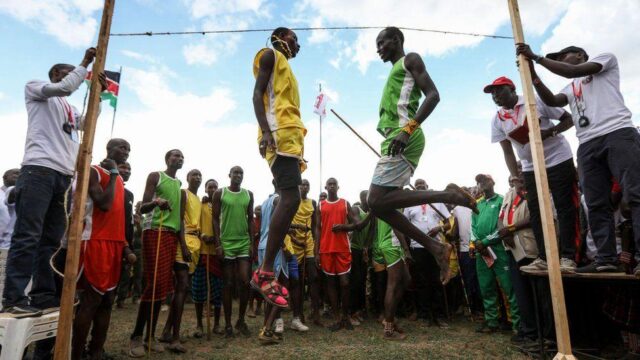In the Maasai culture, there is a time-honored tradition where males kill lions to prove their rite of passage into manhood.
Amid a decreasing number of lions, the community is steadily moving away from this culture of hunting down predators and choosing to protect them instead. Numerous programs have been initiated in this regard, including the biennial Maasai Olympics.
Held for the fifth time, thousands of spectators dressed in traditional red cloaks and beaded jewelry gathered to watch at least 160 young Maasai men and women compete in a series of sporting activities recently.
Some of the events staged during the competition include spear and rungu (club) throwing, sprints as well as the famous Maasai high jump.
Beginning August 2022, the four competing warrior villages of Eselengei, Kuku, Mbirikani, and Rombo have taken part both in the local and regional competitions.
Ming’ati Ole Samanya, a 59-year-old elder from the community, spoke to KBC Digital. He narrates with pride how he has been part of the trainers of some of the competing warrior villages since the event began back in 2009.
He has seen it all and Semanya speaks of how he has observed firsthand the damage the community caused as its sons pursued the lions dwindling their numbers at an unprecedented scale. He says if the rate at which the predators were being taken down continued, it would have ultimately led to their extinction.

“In my hey days, I killed two lions, at that point, I received my “lion name” Mingati in the Maa language. I was one of the toughest young morans during my youth. During hunting, crowds thronged behind me as they watched me go in for the kill. For the first lion, I had my spear run through the head while the second one hit the neck rendering them dead. We would then skin the lions and parade through the community donning their skins to show that we had conquered, this was a moment of pride for us,” he said.
Semanya, however, acknowledges that things have since changed for the better ever since the community made a commitment to protect the lions in their ecosystem.
He is among a group of community members who now work closely in partnership with organizations such as the Kenya Wildlife Service (KWS), Big Life Foundation, and the county government to carry out awareness, especially about the dangers of killing lions during initiation.
He is now a champion for the Olympics as it benefits the community financially while also acting as an avenue to preserve the ecosystem.
“As a community, we benefit from tourism, athletes get small tokens for participation, and business for most women who run local kiosks get a boom in business during the Olympics.” He said
The research found that 87% of warriors aware of the Maasai Olympics reported the event made them less interested in killing a lion and 91% said it made them more interested in lion conservation.
The initiative is now in its 10th year and is organized by Big Life Foundation, a community conservation Non-Governmental Organization operating in Amboseli, in the Southern parts of Kenya.
Craig Miller, Chief Operating Officer of Big Life Foundation says Maasai elders and officers from Big Life came up with the idea as a way to discourage the culture of lion killing from the community, historically one of the key threats to lions in Amboseli.
“Back in 2003, there were only 20 lions in the entire Amboseli ecosystem, and at that point, we approached the community and they said they would afford to keep living with wildlife because of the constant human-wildlife conflict they experienced,” he said.

In addition, the community members resolved to seek compensation for any loss occasion by the animals as a way of living in harmony with the wildlife.
These talks were the culmination of the Predator Compensation program in 2003 which saw the mitigation of economic loss of livestock.
“The Minialayok, Fathers of the boys, approached Big Life and said that compensation was working but morans are still competing to kill lions. They then suggested that they had looked around other countries and realized that the youth were engaged in sports. This is how the Maasai Olympics was birthed. Warriors were pulled into the competitions and the killings declined,” said Miller.
This year’s event, according to the COO, was more gender-inclusive as it incorporated more competitions in which women would take part.
Lion Guardians, an NGO, has monitored a six-fold increase in the Amboseli lion population between 2004 and 2020, making it the fastest-growing lion population on community-owned land in Africa, an astonishing turnaround following near extinction at the turn of the century.
Globally, lions have lost 94% of their range since the start of the 20th century. Today there are estimated to be 23,000 lions left: fewer than elephants, rhinos, or gorillas.






















